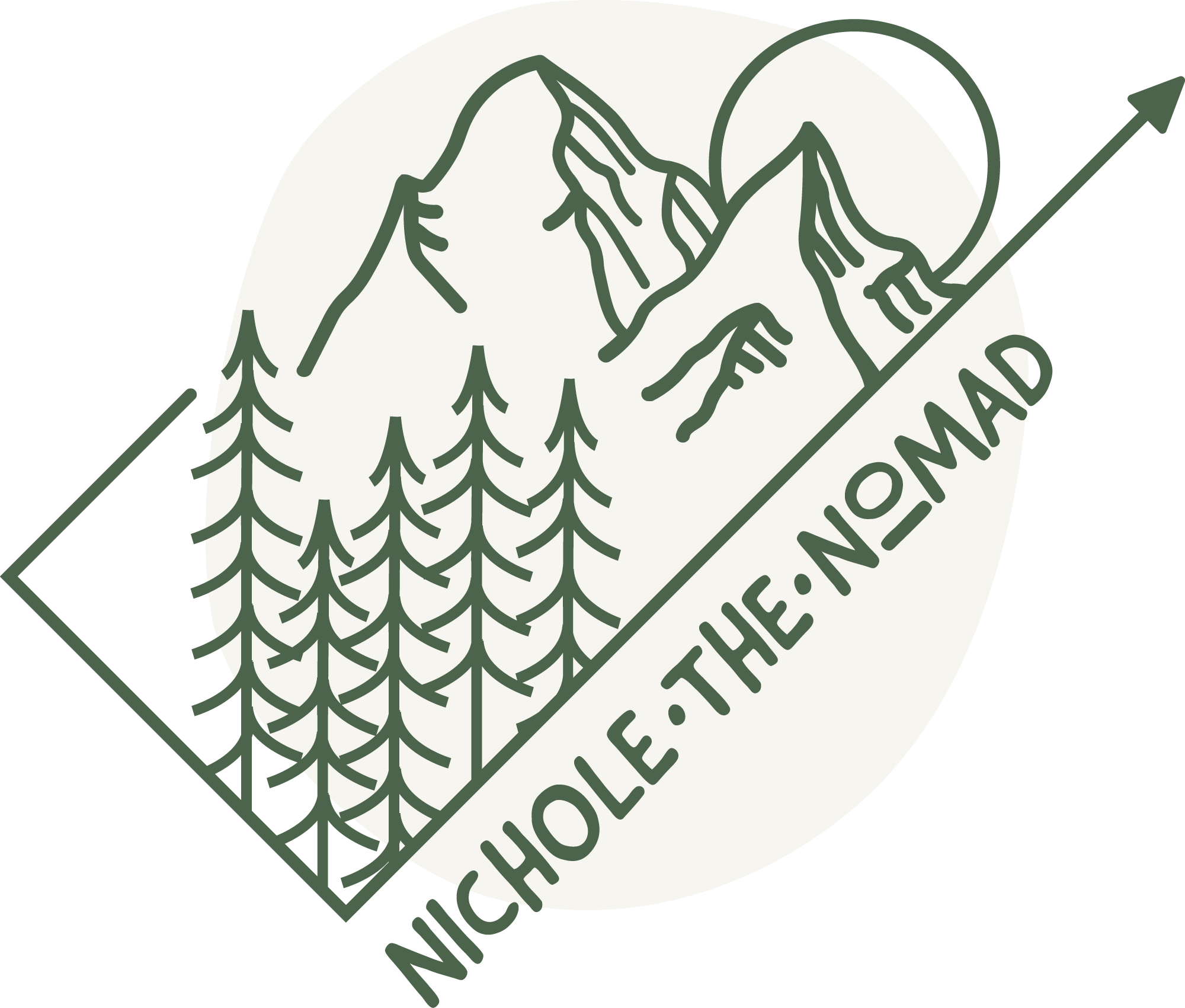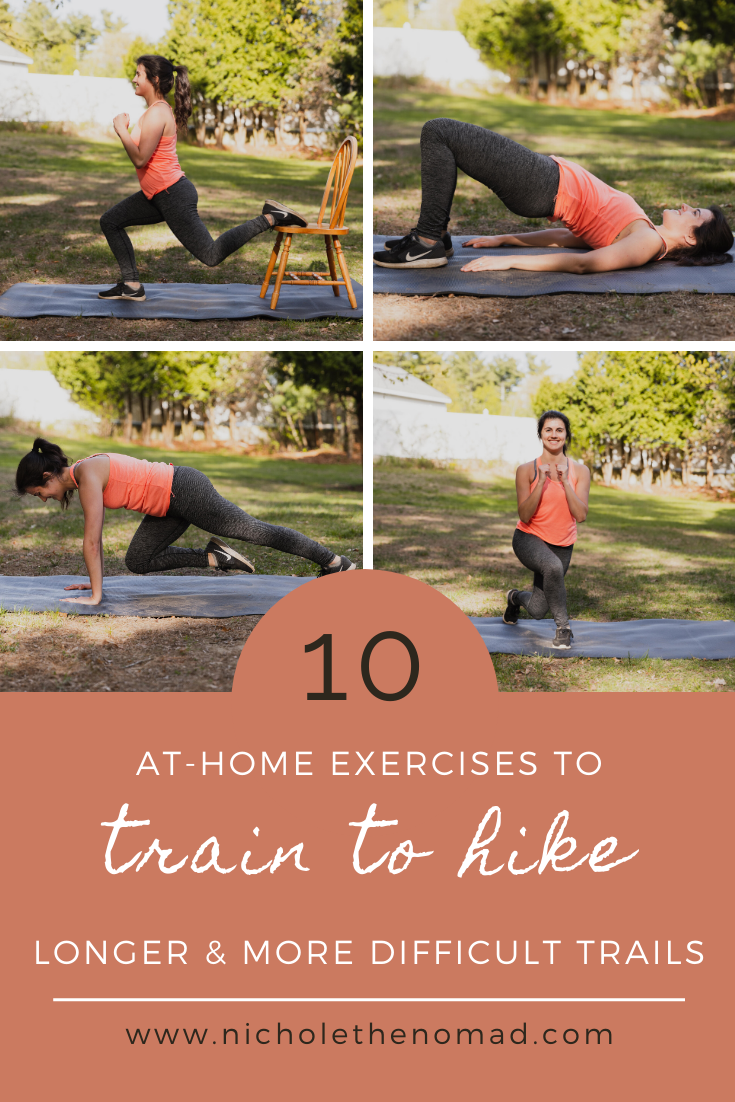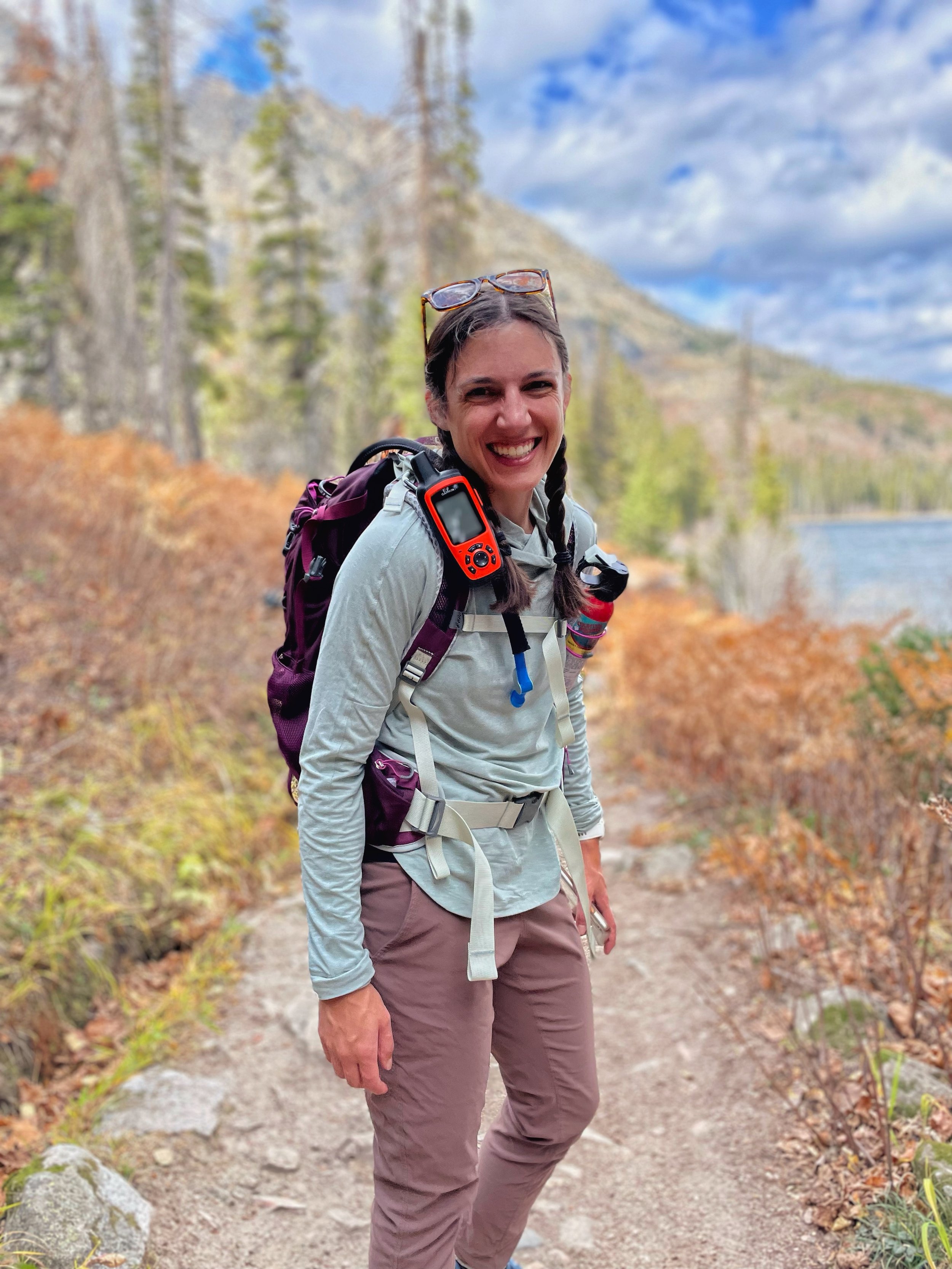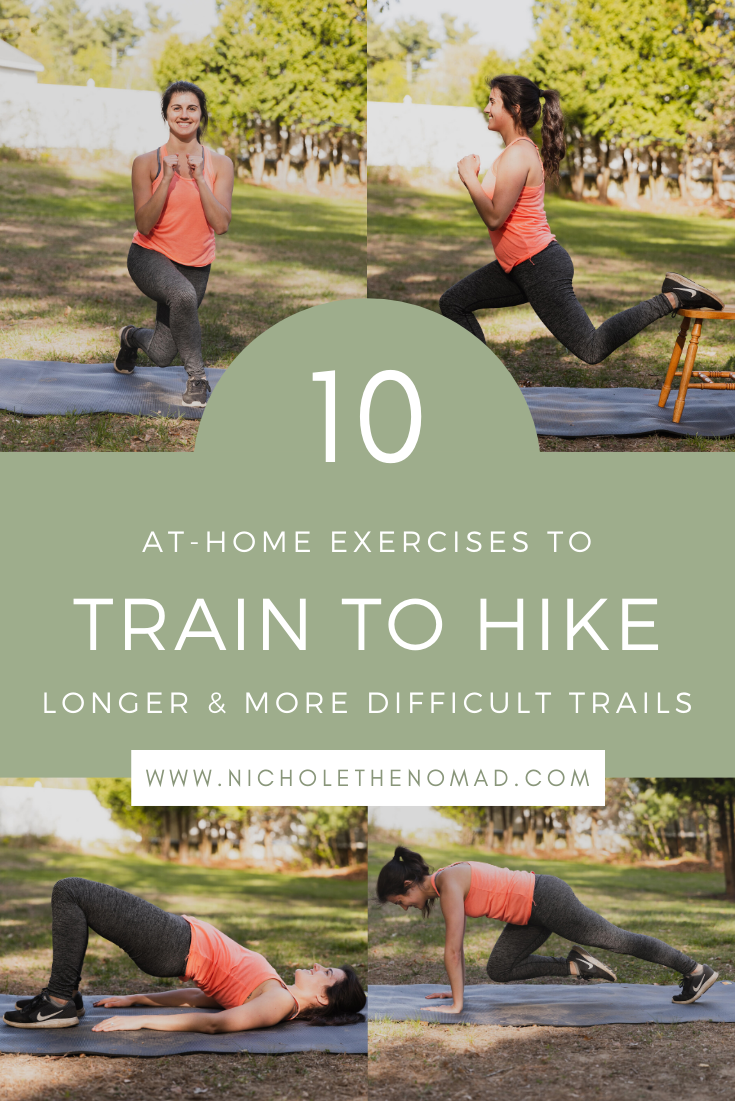How to Train to Hike: 10 At-Home Exercises
Hiking is an incredible activity (and my absolute favorite), but it isn’t always easy. Those beautiful mountain views don’t come without sweat and sore muscles! I am going to help you feel prepared physically to tackle the mountain trails by providing you with a guide that helped me train to hike.
I’m going to be honest, when I went on my first hike, I did not prepare at all. I have always worked out to some extent, but not enough to tackle my first hike. I was sore for days! I knew if I wanted to continue hiking, I needed to prepare my body, so not only would I feel good hiking up the mountain but also work my way up to tackle longer and more difficult trails. I started playing around with different exercises, and after a few years, I finally found what worked to help me get in hiking shape!
Meet your go-to personal trainer for all things training to hike:
To give you the best hiking training starter pack, Certified Personal Trainer Katharine Moustakes of KATHLETICS is joining us for this blog! Katharine has been a Personal Trainer for over 7 years and helps hikers increase strength, endurance, and stability for the trails. She’s trained hikers worldwide who have various goals of trekking shorter local trails, summiting 14ers, completing day hikes, exploring on multi-day international backpacking trips, and everything in between. Katharine takes a comprehensive approach to training to make sure hikers are well prepared for the mountains. Learn more about her strength training program for hikers.
There are 6 parts to this training to hike guide:
Warm-up
Lower Body
Upper Body
Cardio
Stretch
Mental Toughness
Each part holds a unique purpose when training to hike, so one should not be overlooked. I will say that no matter how much I train to hike, I still huff and puff my way up the mountain to some extent, BUT my body feels stronger during the hike and muscles less sore after. These exercises have helped me improve my strength, endurance, and balance to become a better hiker.
Disclaimers:
1. Before you begin any exercise, always consult with your doctor or a certified training professional.
2. This post contains affiliate links. If you click through and make a purchase, my blog may receive a commission at no additional cost to you.
Before we begin…
There are a few things to note before we dive into the exercises to train to hike.
Proper form: It is so important to maintain proper form when doing any exercise. If you need help with proper form, please reach out to a reputable personal trainer to assist you.
Reps: How many reps you do of each exercise in each set is up to you! For me, I have noticed a difference in my hiking ability by doing more reps. If you’re just beginning to add resistance training to your regime, aim for 8-15 reps for most exercises.
No equipment necessary: These exercises do not require any equipment which makes them great for at-home workouts! I’m not a huge gym person, so I have loved being able to do these exercises in the comfort of my home. That has also allowed me to experiment with modifications and progressions without feeling intimidated.
Change it up: If you have been keeping up with these exercises for 4-8 weeks and are looking for more difficulty, first of all, YOU GO GLEN COCO! Secondly, you can add weights or resistance bands to any of these workouts to make them more difficult. I will share suggestions with each exercise.
Listen to your body: THIS IS SO IMPORTANT!! If something feels weird on your body, skip the exercise or modify it! If you’re still not feeling it, choose a different form of movement such as walking or light stretching to keep the habit going.
Part 1 to Train to Hike: Let’s warm-up!
Before I begin any workout, I always warm up. The last thing anyone wants is to pull a muscle from not warming up their bodies! I typically go for a short walk or get my heart rate going with jumping jacks, high knees, or butt kicks followed by some dynamic stretching to get the blood flowing. I try to warm up for at least 5-10 minutes to make sure my muscles are ready to go!
Part 2 to Train to Hike: Let’s get those lower bodies moving!
Alright, let’s jump into the lower body exercises to help train for hiking. The lower body is what takes you up the mountain, so let’s focus on our legs and glutes and get moving!
1. Squats
Squats are AMAZING because they require stability from your core and can strengthen your quads, hamstrings, and glutes. All things needed for hiking!
Stand with your feet facing forward or slightly angled out and shoulder- to hip-width apart
Keep your neck neutral, chest open, back straight, weight equally spread through your feet, and core engaged
In a controlled manner, lower into the squat by bending at your knees and sending your hip back. Keep your knees in line with your second and third toes.
Push through both feet and use your quads and glutes to stand back up into the starting position
Progressions:
Add jumps: Start in a squat position then jump up and land back in a squat position
Add a resistance band: Adding a resistance band above your knees or at mid-shin provides extra resistance for the quads and glutes (be prepared to feel the burn!)
Add weight: Hold dumbbells in both hands by your sides while squatting, hold weight at your chest, or use a barbell for a Back Squat
2. Bulgarian Split Lunges
A Bulgarian split what?! Don’t worry, we will go over this amazing exercise! A Bulgarian split squat is essentially doing a single-leg squat with your back foot elevated. It not only strengthens your leg muscles but also improves balance! If you would like to modify the Bulgarian split squat, keep your back foot on the floor instead of elevating it.
Find a platform to put your back foot on; a bench, step, or sturdy chair are great options
Start by sitting at the edge of the platform, extend both legs out, and use that spot as a marker for where to plant your foot
Keep your neck neutral, chest open, hips square to your body facing forward, and core engaged
Lower into the split squat by bending at your knee and sitting into your hips. Keep all three points of your foot in contact with the ground.
Push through your whole foot and use your quad and glute of the front leg to stand back up into the starting position. Keep most of your weight in the front leg throughout the exercise.
Once you have completed the reps with one leg, switch to the other
Progressions:
Add weight: Hold weights in both hands by your sides.
3. Curtsy Lunges
Curtsy lunges have been a staple in my workout routine for the past few years. They target more than just the quads and glutes, including inner thighs and glute med. They strengthen the lower body in a lateral position for improved balance!
Stand with your feet hip-width apart and facing forward
Keep your neck neutral, chest open, back straight, and core engaged
Step one foot back, behind, and outside of the opposite foot and bend at your knees and hips to lunge
Push through your whole foot and use your quad and glute to stand back up into the starting position.
Once you have completed the reps with one leg, switch to the other
Progressions:
Add weight: Hold weights in both hands by your sides or hold one weight at your chest while lunging
4. Step-Ups
If there was an exercise that best mimics hiking, step-ups would be it! Hiking uphill is very similar to doing continuous step-ups. Training to hike requires strengthening the glutes and quadriceps to tackle elevation gain, and step-ups target both. Step-ups help build endurance, strength, and balance, so get ready for your new favorite exercise!
Find a platform to put to step up on; a step, training box, or bench are great options
Start by standing in front of the platform with one foot on the floor and the other on the platform
Keep your neck neutral, chest open, back straight, and core engaged
Use your glute and quad of the foot that is on the platform to step up and bring the other foot onto the platform
Use the same leg to step down off of the platform, so both feet are on the floor
Switch to the other leg for the next rep
Progressions:
Add weight: Hold weights in both hands by your sides or hold a weight at your chest while doing step-ups
Add height: Use a higher platform to step up on
Go lateral: Instead of standing in front of the platform, stand with it to the side and step up onto the platform (this will help engage your glute med, which also helps with stability on the trails!)
5. Glute Bridges
Glute bridges are one of my favorite exercises because these make you feel the BURN! They work your glutes and hamstrings.
Lie on the floor facing up with your arms at your side, knees bent, and feet flat on the floor. Plant your feet in a position where your knees will be at 90-degrees when your hips are extended.
Keep your core engaged by keeping your ribs down and tailbone slightly tucked
Push through both of your feet and lift your hips off the floor until they are in a straight line with your knees and shoulders
Slowly lower your hips back onto the floor into the starting position
Progressions:
Elevate your feet: To add a level of difficulty, elevate your feet on something sturdy like a couch, bench, or step before lifting into a glute bridge
Raise a leg: Before lifting into a glute bridge, lift one leg over your hips to focus on the single leg
Add a resistance band: To feel an even bigger burn, add a resistance band above your knees when doing regular or elevated glute bridges
Add weight: Hold a weight with both hands across your hips
6. Calf Raises
Calf raises are pretty simple but effective when done correctly. Calves are used a lot when hiking and often overlooked when training to hike.
Stand with your feet hip-width apart and facing forward
Keep your neck neutral, chest open, back straight, and core engaged
Push through the balls of your feet to slowly raise your heels until you are standing on your toes
Slowly lower back down into the starting position with both heels on the floor
Progressions:
Add weight: Hold weights in both hands by your sides while doing calf raises
Add a deficit: Stand on a step or elevated surface and let your heels hang off the step to get a fuller range of motion in the calf raise
Try single leg: Instead of raising both heels at the same time, perform reps all on one side before switching to the other
Part 3 to Train to Hike: Let’s get those upper bodies moving!
Just because hiking requires a lot of leg muscle doesn’t mean the upper body isn’t just as important! Building strength in your upper body can help with balance while hiking. I mean, who wants to fall while hiking? Yeah, me neither. Upper body strength can also increase your ability to carry a heavier daypack. (Aka more room for snacks!)
7. Push-Ups
Now, I know most of you are like, “UGH WHY PUSH-UPS?!”, and I feel you. I have a love-hate relationship with push-ups, but I do them because they are an effective upper body exercise. I have been incorporating them into my workouts lately and have noticed a big difference in my strength. And yes, they will help you when hiking because they will strengthen your arms, back, and core. If you need to modify, do push-ups on your knees or at an incline.
Start in a high plank position with your hands underneath your shoulders and feet hip-width apart
Keep your legs, arms, and back in a straight line
Bend your elbows at a 45-degree angle away from your shoulders and lower your whole body until your chest is right above the floor
Push up through your chest to return to the starting position
Progressions/Regressions:
Perform at an incline: Use a bench, box, or wall to complete the reps at an incline. Minimize the incline over time as it gets easier.
Do knee push-ups: If incline push-ups aren’t available, swap for knee push-ups until they get easier
Take it slow: Slowly lower into a push-up position, hold with your body right above the floor then slowly push your way back up
8. Mountain Climbers
No, I didn’t choose mountain climbers because they have the word “mountain” in the name. I chose mountain climbers because it is a great full-body workout. It strengthens your legs, core, and arms and builds endurance. Mountain Climbers will be one of your new favorite exercises!
Begin in a high plank position with your hands underneath your shoulders, feet hip-width apart, and legs and back in a straight line
Keep your hips in a straight line with your body during this whole exercise
Drive one knee toward your chest
Extend that leg back into the high plank position
Drive the opposite knee toward your chest
Alternate sides to complete all reps
Progressions:
Change the speed: Increasing the speed at which you do mountain climbers can add a challenge to the workout
Add a hold: When you bring your knee into your chest, hold it there for a few seconds before switching to require extra core engagement
Switch it up: Instead of bringing your knees to your chest, bring them to your elbow; You can do the same leg as elbow (i.e. right knee to right elbow) or cross it (i.e. right knee to left elbow)
9. Planks
I LOVE PLANKS! I think these are one of the best core strengthening exercises, and I have seen a big improvement in my core since incorporating them into my routine. If done correctly, planks can also strengthen your shoulders and legs. Planks also improve your balance and posture. You have an all-around great exercise here!
Start in a forearm plank position with your feet hip-width apart and forearms parallel to each other
Keep your legs and back in a straight line by engaging your core and tucking your tailbone
Hold this position for at least 20 seconds
Progressions/Regressions:
Go to the side: Start in a plank position then rotate to the side on one arm with your legs and feet stacked on top of each other and hold; move back into a plank position then rotate to the other side
Add a dip: Start in a plank position and rotate your hips to one side to dip your body and almost touch the floor then return to the starting plank position and repeat to the opposite side
Swap for a High Plank: Place your hands underneath your shoulders instead of coming down to your forearms
Perform at an incline: Elevate your hands or forearms on a box, bench, or similar to make it a little easier
10. Supermans
Don’t think I didn’t forget your back! Your back plays a large role in posture and balance and should not be overlooked when it comes to training for hiking. Supermans help strengthen your back and core.
Lay on your stomach with legs extended and arms reaching out in front of you
Lift your legs, chest, and arms off the ground by engaging your back, glutes, and hamstrings
Return all limbs to the ground between each rep
Part 4 to Train to Hike: Let’s get those heart rates going!
It is time to get those heart rates pumping! Cardio is just as important as building muscle when training to hike because it helps build endurance and stamina and increase lung capacity. Cardio is great for training for longer hikes.
This portion of your workout can be anything you enjoy doing! Going for a run, bike ride or walk are all great cardio activities. I typically do a cardio activity for at least 20 minutes a few times a week. If you want to level up on your cardio, try high-intensity interval training (HIIT). High-intensity interval training is when you go all out and give 100% for quick bursts with recovery periods in between.
Part 5 to Train to Hike: It’s time to stretch.
I would argue that stretching feels just as good as a post-hike meal. Stretching can help reduce the risk of injuries, improve recovery time, and increase flexibility. I dedicate at least 15 minutes to stretching after I complete my workout and hold each stretch for 20-30 seconds, although even a quick 5 minute stretch can feel great. I focus on stretching every muscle group every time I exercise even if I don’t complete a full-body workout.
These are the 10 best stretches for hiking that you can incorporate into your cool down.
Part 6 to Train to Hike: The part no one talks about.
Hiking isn’t all about physical strength. Being out on the trail and hiking tough and rugged terrain requires you to not only push yourself physically but mentally, too. Mental strength is often overlooked when training to hike, but it is just as important. You have to be comfortable with being uncomfortable, prepared to push past limits, and overcome hardship you may face on the trail.
Training your mind doesn’t have to be a crazy or overwhelming process. An easy way of adding mental exercises to your workouts is adding a few more reps to an exercise you don’t necessarily enjoy. Yes, you are pushing yourself physically, but you are also mentally pushing yourself outside of your comfort zone. I also pick something I don’t enjoy (outside of workouts) and push myself to take the challenge on a few times a week. For example, I don’t enjoy speaking in front of large groups of people, so a few times a week when I’m on a team call for work, I’ll push myself to talk about an idea I have or provide my thoughts on a topic we discuss.
Pushing myself just a little bit a few times a week has helped build my mental toughness!
And that’s a wrap on how to train to hike!
These exercises have helped me become a better and stronger hiker. BUT to that point, everyone’s bodies and muscles are different, so make sure to take time to try out different things, find what works best for you, and work with a certified personal trainer if you’re looking for an additional layer of guidance and accountability.
Hey, I’m Nichole!
I am the creator behind Nichole the Nomad, the home of my explorations around the world, mountain hikes, and beautiful pictures taken along the way. I have a deep passion for capturing the world in a beautiful light and sharing my experiences.
I created this blog to share my travels, show how beautiful the world is, provide tips and tricks for traveling, and encourage you to explore. Whether you want to travel across the world or explore what’s in your backyard, I hope this blog inspires you to get outside and find your adventure!
Pin it for later!


















